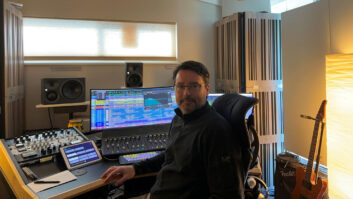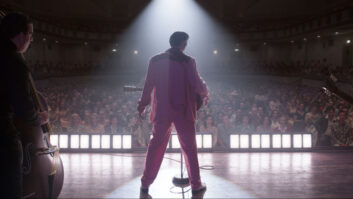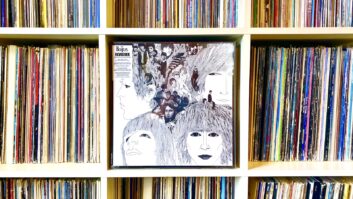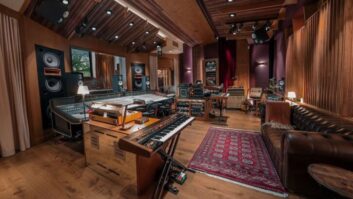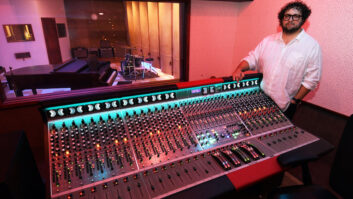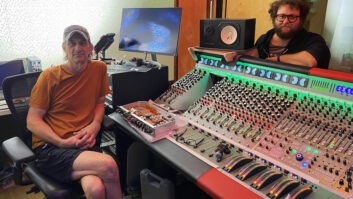Kevin Killen has worked with some of the most brilliant artists in pop music. His diverse discography is evidence that he’s an all-around type, with the ability to go with the flow of an artist’s vision while still keeping both feet solidly on the control room floor. That discography contains at least one indisputable masterpiece-Peter Gabriel’s So. He’s done five albums with Elvis Costello, including the much-lauded The Juliet Letters, and he’s engineered and mixed for U2, Marc Cohn, Shawn Colvin, Jane Siberry, Sam Phillips, Bryan Ferry, Lindsey Buckingham and Kate Bush. His recent work has included mixes for the chart-topping The Book of Secrets from Loreena McKennit, and for Spirit, Jewel’s latest CD.
A resident of Manhattan who was born in Dublin, in person Killen evinces the characteristically Irish trait of understatement-a kind of bottom-line practicality that doesn’t allow for the attaching of undue importance to matters. But under that practical surface are some other characteristics common to the Irish: passion, a sense of humor, a highly literate sensibility, and an innate understanding of magic and romanticism.
When Mix visited with him to share a cup of tea at his home on New York’s Upper West Side, he was taking a break from mixing for Columbia artist Kim Sozzi and recording and mixing for Sophie B. Hawkins’ latest.
How’s the New York studio scene these days?
There are a lot of great rooms still, but when I first moved here there were more. There was Power Station, CBS, RCA, A&R, Skyline Studios-a lot of those big tracking rooms don’t exist anymore, and it’s a shame. I think Hit Factory has the biggest room in the city now, and there’s also Clinton, which is a good, big room with an old Neve that’s great for orchestras.
Do you like to work on older equipment?
Well, I love the way the old Neves sound, and I also like a lot of the new equipment-the Capricorn console, the new 3348 HR machine, and I’ve been using Pro Tools when it’s necessary to re-jig the tracks. I like technology, but it has to be for the right set of circumstances-not just to say, ‘You have to use this because it’s what I always use.’ The old gear definitely has more personality, but the new stuff allows you to do things you couldn’t possibly have done ten or 20 years ago. It’s a great thing to be able to take five different drum performances, manipulate them and get the best without ending up with a track that feels stilted. You can do that now and still keep life and integrity in a performance.
I don’t think of Dublin as being much of a recording center before U2-how did you get into the business?
I started in Dublin in 1979. The traditional Irish music scene was actually pretty healthy at the time, with The Chieftains, of course, and Clannad. There was also Thin Lizzy, the Boomtown Rats…
I was in Trinity College studying sciences, but very interested in music, and a friend of mine told me there was a studio in town looking for a trainee. The studio was called Lombard, and the studio manager was this crusty old character named Pat Murphy, who asked, ‘Why do you want to work in the studio business? It’s late hours, the pay is lousy, you drink way too much coffee and you don’t get much sleep.’ I said I thought it was interesting work, and he decided to give me a job based on the fact that he liked the jacket I was wearing, which was my father’s.
Oh, come on.
No, he told me afterwards it reminded him of something he wore in the ’40s, so he thought I must be okay. Think of it-some stupid thing like that and I started working at a studio, and I stayed almost two years. It was a jingle house in the morning between nine and one and then an album project studio between two and midnight. At the time the punk/new wave explosion was happening in England, and everyone wanted to be in a band, so the studio let us bring in bands for something like 100 dollars a night for everything. Of course, we’d stay up all night and work, and within six months I was already engineering.
How did you get to Windmill Lane?
I worked with this one jingle writer over a couple of months. One morning I did a session with him, and that afternoon he went down to Windmill Lane to work on another session with Brian Masterson, the chief engineer. When they finished he asked Brian to run off a transfer of what we’d done that morning and, as Brian was doing it, he was listening, and he asked who the engineer was. The client said, “Oh, it’s Kevin up at Lombard who’s actually quite good.” I got a call the next day, saying there might be an opening.
It was the best studio between London and Dublin, and I thought it would be a very good move, so I went and stayed for close to four years. I had to go back to doing assisting, but the longer I stayed, the more engineering I did, and I got to work on some great projects.
What was it like to work with U2 back then?
It was great fun. At first it was mostly assisting, then more engineering as time went on. The War record was the first record I worked on with them, and we did the whole record in six weeks with Steve Lillywhite. The days were really long, and it felt like this little communal project that everybody was in together-you felt that you were part of something special. And working with Steve Lillywhite was an incredible experience. He had great energy in the studio and was the perfect producer for them at that point in their career; he really helped to shape it.
At the end of four years it was, “Shall I stay a full-time staff person and work in a small market or should I move somewhere else?” That was 1984. My boss, Brian, encouraged me to spread my wings and consider moving-being Irish in London wasn’t a big advantage, so I thought I might come to New York. And I came over here, not having a job, not knowing whether I would stay, not really knowing anybody. I just threw caution to the wind. It was difficult-it’s not an easy transition to come from a different country. Even though it’s English-speaking it involves proper working papers, things like that, although it wasn’t as strict then as it is now.
But even before you got established in New York you found yourself back in the British Isles.
Yes, Daniel Lanois was to be producing an album for Peter Gabriel. They were going to record in what was actually a cow shed on Peter’s property near Bath, England, and originally Daniel thought he’d bring an engineer in for the mix. He knew I’d up and come to America, so he thought I had the courage to tackle the task. Once they got going on the project they called me to come over and help record as well.
A cow shed.
Yes, the worst thing is that it really was very cold.
When I arrived there were two analog 24-track machines, a Studer A80, and a Studer A80 shell that had been modified by a local electronics wizard, with its own audio cards and transport controls. A month before I arrived, as Dan explained it to me, and the day before the band arrived for basic tracking, Peter had installed a synchronizer to link the two machines, and somehow the two machines weren’t talking to each other properly. The stock Studer had an FM card and the modified Studer had a DC card, and the synchronizer thought they were both FM cards, so there were incorrect pulses being sent to the second machine. The way Peter was working, he had a demo of each song with piano, maybe a Prophet pad and a Linn drum machine, that he would put up on the B machine, which was the modified machine, and he would play that to the musicians in the studio. They would then play along with that in their headphones, and record all their parts onto the A machine. They’d also copy some parts across from the demo to the A machine. They’d do a couple of takes, say on “Sledgehammer,” and instead of leaving the demo reel up on the B machine they would take the first set of performances and put that bit on the B machine, so the musicians could then hear that in their headphones along with the demo rhythms-all that information was getting transferred across to the A machine along with the second set of performances. And they kept doing that, so they could constantly reference quickly back to a part they’d just played.
They were recording new takes while hearing the previous ones, and running two machines all the time.
Yes, and what happened was that the two machines were slipping ever so slightly. With each pass the problem got compounded, so that when you took tape one, and locked it up to tape six, they drifted. Add to that the fact that Studer A80s are notoriously unreliable at the front and back of the reel, and it made for a real mess. There were parts of each performance that you simply couldn’t sync together.
But they had all these great performances, and it became my job to corral them together. Dan and Peter sat down and built up lists of what they wanted to get, say from tape six to tape one on the same song, and we planned to somehow edit these pieces together.
I arrived around the end of May, and the first part was getting familiar with the songs. There were musicians coming in during the day, and Peter was working on vocal ideas, so we had to try to isolate a performance that would be the master track of the song, and somehow keep tracks open so that we could edit in the pieces that we wanted from other takes. Late at night, after Peter had left, we’d work on retrieving the tracks we needed.
The musicians were overdubbing to parts that weren’t final?
Yes, but with Peter-and this is probably true to this day-you’re never really sure of what the final part is going to be, because he’s constantly writing the lyrics, and seeing what will work. Sometimes he’d come up with a great lyric, and there’d be some part that didn’t work with the vocal-so we were constantly changing.
Finally, I decided the best way to proceed would be to edit the multitracks into a more structured form and put it on one tape machine that we knew was reliable. In New York I’d used the Mitsubishi 32-track, and I proposed that we should get one. Then I set about editing whatever needed to be done-if there were four reels per song, I would have to do the same edits on each reel and hope they all were good. The process of getting stuff back from slave reel number five to master reel number one involved sometimes lining up the 2-inches and flying between them manually, bit by bit. In July we got an AMS sampler with 14 seconds of sampling time, so we could actually sample four or five measures of music and fly it in that way, which helped. By September we had everything over to the 32-track machine.
But when you mixed you ended up locking three machines anyway.
Yes, Peter felt that some things sounded better coming off the analog, particularly certain percussion elements, and he was right. But then, we never really sat down and mixed, you see. Most records get broken down into periods-pre-production, tracking, overdubs, the mix. With Peter, we never really entered into those phases. We were always mixing. So by October, we’d put up a mix, with whatever overdub had been achieved that day, and I would always store the mix on the SSL and take down documentation. Then, at some point we’d decide, “That’s a really good reference for that track,” and from then on we’d always reference back to that particular mix. So, if all of a sudden we were having background singers come in, we’d recall the mix and do all the patches, crosspatches, etc., so that they would hear the best possible interpretation of the song. By the time the album was “mixed,” the mixes had already been going on for three or four months. And, of course, the patchbay was a mess. You couldn’t see anything.
Do you remember how you recorded Peter’s voice?
We used a tube 47. Peter always maintained that he’d used a handheld 57 in the control room on his previous records. Dan and I were skeptical, so we did a test. We set up a bunch of mics, and we blindfolded Peter and had him sing into each and tell us which one he liked the best. It came down to one, and he was sure it was the 57. When we took the blindfold off, of course it was the 47.
But there was a funny sound to that 47. It had much more air than you would normally expect-very pleasing sounding, but not as much bottom as you’d expect. We had our maintenance guy, Neil Perry, take a look and it turned out that one of the cables had a little nip in it. It wasn’t getting full contact on the shield, and when he reconnected it back up it sounded much fuller-but the presence that we loved was gone. So we rigged up a system where we plugged the output of the mic into the patchbay, and we took the shield off a regular patch cord and used a mult of the two things; we brought the mic up on two faders to duplicate that sound-the regular 47 and the dropped shield version of it-and we’d balance between them.
What about the rest of the chain?
Peter had an old Decca compressor, kind of like an LA2A, very smooth, very slow. I set it up for a minimum amount of compression. I chose not to use a lot of EQ, mostly because I knew we’d be dropping in lines further down the road. We’d have EQ on the monitor side.
What outboard equipment did you have?
We had an AMS DMX1580 and an RMX16, an EMT 140 plate, and we used the studio as a chamber. I recall a Sony DRE1000 reverb unit, four Decca compressors, a couple of LA2As, and tape slap. Not a lot of outboard-we printed effects as we went along. The console was very small; I think just 56 in. We only had six echo sends, because I was using so many of the small faders for tape returns, and we had to constantly figure out different ways to get into devices. We would often chain effects together-send a signal to the AMS for delay, then out of that into another delay, like the Deltalab DL2 with the extra delay module that gave almost a second of delay time. We’d do a lot of things that would shimmer back and forth, then come out of that and patch into a reverb: By sending one thing you could get three effects.
Did you know you were working on a great record?
We knew it was good, but I don’t know that we knew it was going to be one of those hugely successful records, because it took ten months and by the time we were finished we were just relieved to be done.
I sent a copy of the record to my friend Randy Ezratty in New York, and after he listened, he said, “You’re going to get so much work from this, you have no idea.” And he was right. The So record was very pivotal for me. I’m sure without it I would have had some success, but that tended to put me in a different place. Since then I’ve gone through periods that got a little dry, but for the most part people say, “You’ve done that record and you’ve done this record, therefore there’s a level of consistency between all your work.” Which is really what you want people to look at-you want them to judge you from your whole body of work, as opposed to just the last record that you did.
Your credit on Elvis Costello’s The Juliet Letters reads “recorded, engineered and balanced by…”
Yes, it really was a capturing of a performance in a room, and I think Elvis wanted the credits to accurately reflect that. We didn’t do any editing between tapes, and there were no drop-ins. We found a space we thought would sound good for the quintet, a studio in London called The Church, owned by Dave Stewart of Eurythmics, and we set about just trying to capture that sound-unlike some records where you reshape the sound of the record or you redirect it, perhaps in a direction the artist had never imagined going.
They’d performed the pieces in a couple of different venues in London, and had settled with a setup they liked-two violins, Elvis in the middle, then viola and cello-and that’s how he wanted to do it. But it was such a big space, and so live, that when Elvis started singing he basically drowned out the quartet.
He was using monitors?
No, he was just singing into the room and was still overpowering the quartet. So I built a little house with a hutch on top using baffles and gobos. The sightlines were clear, he was still in the same space as everybody else, but his voice was more contained from the other microphones. I spotted a couple of mics around the quartet, and a couple of stereo room mics and a vocal mic, and that was it. I set the balance, then Elvis worked the vocal microphone, and if the quartet felt something was wrong with the balance, they would adjust themselves.
It was a fun project, because what you heard was what you’d be getting on the record. You weren’t ever thinking, “Well, when we put the horns on here it’s going to be so much better,” or “When we add drums…” If it didn’t work as a quintet it was never going to work.
Some people have a hard time with that record. They think Elvis stepped out of his element and pushed the boundaries too much. But that’s what I love about working with him-he’s interested in all kinds of music and he wants to explore that. He takes a lot of chances.
It’s always a pleasure to work with someone like that. You know the record is going to be of a certain quality and that vocally the performances are going to be spectacular, with a certain emotional intensity attached, be it good or bad. They are intense records, both to make and to listen to. It’s a rollercoaster, but at the end of the day you can say, “This is a really honest piece of work.”
What mics did you use?
One was a Calrec stereo Sound Field. From the control room you could control the shape of the pattern-you could listen on headphones and decide how much of the M/S pattern you wanted, and you could turn the angle around. Other than that, Neumanns-67s on the violins and violas, TLM170s on the cello, and for Elvis a 47.
You do your own engineering when you produce-it’s a big job to do both.
It is, but there’s a rationale that labels apply when they’re looking for a producer/engineer. Some of it’s financial, because they feel they can get two for the price of one, but also they realize that part of your production values are inherent in the sound you get.
It’s a style. Obviously, I developed my craft as an engineer, starting as an assistant, progressing through junior engineer to engineer to producing. I didn’t start out to be a producer; I just always felt that my role was to help make the recording the best possible. I did whatever it took to make the session go as smoothly as possible and to be as creative as possible. At some point people started taking that as an indication that I was capable of producing. Making suggestions, trying things out-it was a natural way to go, and when someone offered me a chance to produce I thought, “Well, I’ll try it.”
Production really is a black art, and it seems at labels these days, everybody thinks the producer is the most important cog in the wheel. But that’s not necessarily true. A good producer can’t turn a bad song into a great song. You can make it sound great, and get interesting performances, but if the songs aren’t there, it really doesn’t matter.
I don’t produce records back to back-I do one or two records a year. I’d like to do more, but it’s not my driving ambition to only produce. I do a bunch of mixing projects, and sometimes I’ll do just straight engineering. Like with Elvis and Burt [Bacharach], where it was just great to be involved.
So you’re more project-oriented than role-oriented.
I want to produce those artists that I really have an affinity for, because if you spend three months in a room with somebody and you don’t like them, it’s a very long time.
If it’s someone you haven’t worked with, you have no idea what they’re going to be like. You have no idea what kind of strange behavior they might exhibit, or what they might perceive as your strange behavior. You’re in that melting pot of the studio, and the pressure’s on to make a hit record, or a successful record-God knows what’s going to happen. You’ve got to make sure you like the person enough to hang out with them for three months.
What equipment do you own?
A rack of 1064A Neve mic preamp and EQ modules, which I picked up at Ocean Way years ago, a TC 2290 and a 1210, a couple of Eventides, a bunch of API 560 graphic EQs, a Manley stereo compressor, a bunch of Distressors, some mics, a bunch of pedals and boxes. I also cart around my own amps, speakers and cables. I use ProAcs. They’re English speakers that I use with a Cello amplifier. I got turned on to them by Randy Ezratty and by Bob Ludwig.
I also have a little portable SADiE workstation, which I really like. I use it for flying stuff around or album sequencing. SADiE is a great company, very dedicated-when I bought the unit they convinced me to put a modem into it, saying, “Your learning curve will be slow in the beginning, you’re going to make mistakes, and that way you can just call us, and we’ll call into the machine.” That’s what I did; they would call into the machine and I’d be on the other line, and they’d control it from their office in Nashville. I was getting a tutorial over the phone.
How would you describe yourself as an engineer? You don’t seem to be hard and fast about anything.
You can’t be hard and fast, because every situation is different. Even though you may be recording the same combination of bass, drums, guitars, vocalists, there will be something unique about that particular combination that you won’t have encountered before. The room, or the performance ability, or the instrumentation-you have to be a bit of a chameleon and to move around and adapt quickly.
It’s easy to go astray. And that’s a function of the methodology of the producer and the recording engineer. I learned from Steve Lillywhite and Dan Lanois to commit to sounds and performances early on. The most important thing is to make decisions and not to leave choices until the last minute, because then you’re left with too many options. And, in the studio, when you have to sift through all the various permutations it could take two days. That drains your energy. It’s better to commit.
I’m mixing a project right now that has 96 tracks of material. It takes seven or eight hours just to sift through and get organized; it doesn’t fall naturally to the fingertips. You’re stretched out all over this huge console and you can’t get things condensed enough to where you feel like you control the track. Instead it’s controlling you. You’re just fighting to get the beast under control so you can do your job of making it a better record. All you’re doing is thinking about where that sound is coming in, and you’re looking at the meter bridge trying to find out where these tracks are-there’s three machines synched up and you’re thinking, why do people work this way?
So for the most part I work 24-track if I can.
Is there a philosophy that has guided your career?
Well, Daniel Lanois gave me a great piece of advice in 1984 during the making of U2’s The Unforgettable Fire. He told me to concentrate on one or two disciplines and become an expert at them. Rather than be a jack of all trades, become an expert at whatever is important to you. And I’m still trying to do just that.

